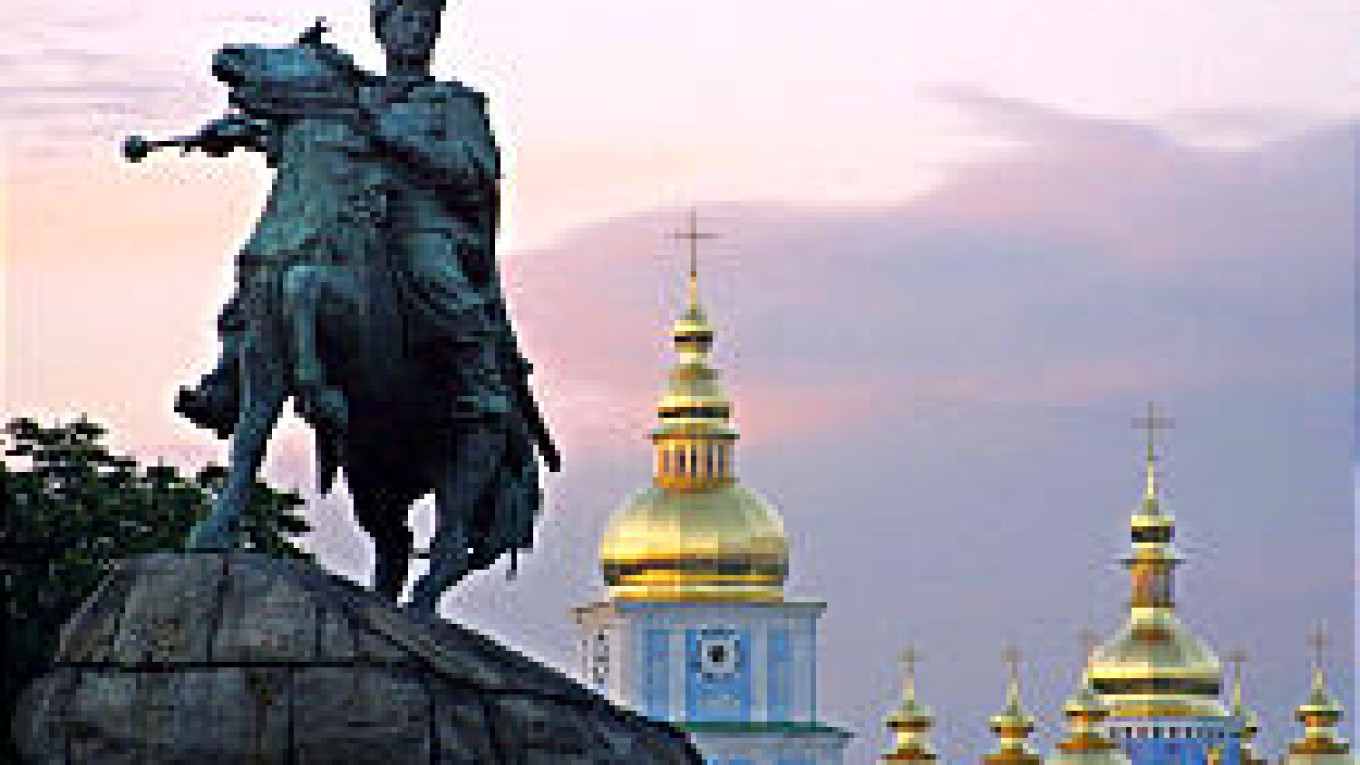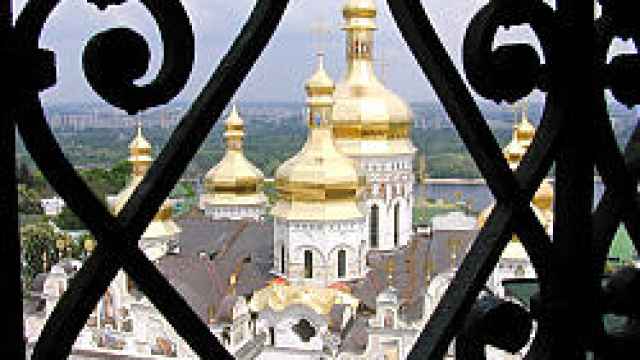A gleaming array of golden churches and monasteries reflects the city's glory years from the 10th to the 12th century, when it was the capital and spiritual heart of Kievan Rus, the first great Eastern Slavic civilization. Steep, cobbled streets and faded mansions evoke its later prosperity as one of the main trading hubs between the Black and Baltic seas.
But Kiev offers more than a dose of nostalgia, for there is an up-and-coming, cosmopolitan feel to the place, too. Strolling along its shady boulevards or sitting in one of the busy, city-center cafes, a first-time visitor might imagine himself in the heart of Mediterranean Europe when the sun is shining and the locals are out for an evening walk.
The modern heart of Kiev is the lively Maydan Nezalezhnosti, or Independence Square, which was the focus of celebrations to mark the 10-year anniversary of Ukraine's independence from the Soviet Union last August.
Encircled by hulking Stalinist blocks, the square is not a thing of beauty, despite efforts to revamp it for the anniversary. Its east side is now presided over by a tall marble column topped by a golden statue of a woman holding an olive branch, that was completed last summer and named "Glory to Ukraine." In keeping with the square's patriotic theme, the ugly hotel overlooking it was forced to change its name from the Moskva to the Ukraina. (The old Ukraina is now the Premier Palace.) And plans are also afoot to build an underground mall that the city government hopes will eclipse Moscow's unlovely Okhotny Ryad.
From Independence Square, Vulitsa Kreshchatyk, Kiev's main street, curves up a valley toward the glass-roofed Bessarabsky market to the southwest. On weekends, the street is closed to traffic, and people gather among the cafes and stalls that are laid out beneath its lines of shaggy chestnut trees and inscrutable 1930s office blocks.
On a hill above Kreshchatyk stands Kiev's oldest church, St. Sofia's Cathedral, which was founded in 1031 by Prince Yaroslav the Wise to celebrate his father Volodymyr's conversion to Christianity. Visitors enter the cathedral complex through its famous bell tower, built in four wedding-cake tiers that taper upward to a golden cupola. The cathedral itself has a pleasant exterior, but its star attractions are the beautiful frescoes, icons and mosaics inside, some of which date back to the 11th century.
To the northeast of St. Sofia's, a broad, paved prospect leads to the dazzling golden domes and lilac walls of St. Michael's Monastery. Founded early in the 12th century, St. Michael's was recently rebuilt after being torn down by the communists in 1936 to make way for a duplicate of the huge, neoclassical Foreign Affairs Ministry building next door. Stalin reportedly intended to construct four of these buildings to stand at the corners of a giant square that would have been created by razing all the buildings between St. Michael's and St. Sofia's. Fortunately, his plan was never carried out.
|
| AP The golden domes of the recently reconstructed Assumption Cathedral, a principal temple of Kiev's Monastery of Caves. |
Winding steeply down a narrow gully, Andriyevsky Uzviz is Kiev at its most old-fashioned, surfaced with rough cobbles and lined with crumbling, stuccoed houses, wooden cafes and a thriving craft market. The street was also the childhood home of writer Mikhail Bulgakov, who described it vividly in his civil-war novel "The White Guard." The Bulgakov house is today an atmospheric little museum, full of family furniture and artifacts, such as Bulgakov's medical equipment.
Once in Podil, don't miss the fascinating, if disturbing, Chernobyl Museum at 1 Provulok Zhoreviy. The museum's photographs and videos emphasize the impact of the 1986 nuclear disaster on individual lives, while betraying the staggering incompetence of the officials responsible for dealing with its consequences.
Despite the fact that Chernobyl is just 100 kilometers upstream of Kiev, the banks of the Dnieper are crowded with bathers during the summer. Hydropark, a low-lying, island across the river from Podil, is one of the most popular spots to cool off, with white sandy beaches and great views of the old town.
If the threat of radioactive silt discourages more cautious travelers from swimming in the Dnieper, a boat trip along the river offers a safer alternative. Many of Kiev's best-known sights are visible from the river, from Soviet-era monstrosities such as the Rainbow Arch (a metal parabola celebrating the unification of Russia and Ukraine in 1654) and the huge Defense of the Motherland Monument (a 72-meter-tall titanium clone of the Statue of Liberty that is less affectionately known as Tin Tits) to the unforgettable Pechersk Lavra, or Caves Monastery, about four kilometers downriver from Podil.
Founded in 1051, the monastery features a stunning concentration of gold-domed churches, a museum of Scythian gold and a 96-meter-tall belfry offering wonderful views over the city. But what makes the monastery unique are its caves, which burrow deep into the hills below the complex and under the Dnieper. In medieval times, the caves were home to the foremost monks and chroniclers of Kievan Rus and the early Russian Orthodox Church. Later, they were used as hideouts by Ukrainian partisans during World War II.
Inside the cramped, candle-lit catacombs, tiny chapels and niches have been hollowed out of the walls to house the glass-topped coffins of mummified monks whose desiccated hands protrude from ceremonial robes. The monks' scowling successors stand by to ensure that visitors behave with due decorum before the remains.
travelers' tips
how to get there
You will need a Ukrainian tourist visa ($65 and higher), available through the Ukrainian Embassy (18 Leontevsky Pereulok. Metro Pushkinskaya. Tel. 229-1079).
Overnight trains to Kiev leave every day from Kievsky Station. A second-class roundtrip ticket costs 1,850 rubles ($58).
where to stay
The Premier Palace hotel (5-7 Bulvar Taras Shevchenko. Tel. 244-1200/05) offers a swimming pool, sauna, gym and other luxury trappings. Rooms start at 1,290 hryvnas ($240).
Travelers on a budget may wish to try the St. Petersburg hotel (4 Taras Shevchenko Bulvar. Tel. 38-44-229-7364), which is clean, centrally-located and inexpensive. Double rooms without bath cost from 160 hryvnas ($30).
where to eat
Kiev is home to a fairly wide range of restaurants. For lunch, try one of the cafes on Andriyevsky Uzviz. Most offer decent versions of local staples like Ukrainian pelmeni and holubtsi (stuffed cabbage rolls).
In the evening, try Kozak Mamay (4 Prorizna Vulitsa), which serves up excellent Cossack fare, or Tsarske Selo (42 Sichnevoho Povstannya Vulitsa), which offers traditional Ukrainian dishes.
… we have a small favor to ask. As you may have heard, The Moscow Times, an independent news source for over 30 years, has been unjustly branded as a "foreign agent" by the Russian government. This blatant attempt to silence our voice is a direct assault on the integrity of journalism and the values we hold dear.
We, the journalists of The Moscow Times, refuse to be silenced. Our commitment to providing accurate and unbiased reporting on Russia remains unshaken. But we need your help to continue our critical mission.
Your support, no matter how small, makes a world of difference. If you can, please support us monthly starting from just $2. It's quick to set up, and you can be confident that you're making a significant impact every month by supporting open, independent journalism. Thank you.
Remind me later.




